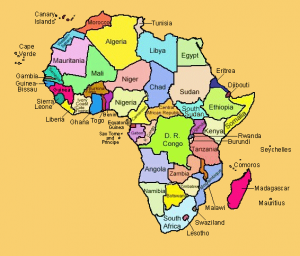By: Michelle Benavidez
Abstract
Historically, reliable access to energy has accompanied the success of a growing economy. Reliable energy provides people with improved standards of living by creating the ability to maintain clean water and sanitation. For modern society, energy represents a basic need and providing affordable access to everyone has become an unequivocal goal as well as a problematic endeavor, especially for poor and developing countries. Among all the countries in the world, those located in Sub Saharan Africa (SSA) have amongst the lowest rates of energy access. For this reason private and governmental groups, primarily from developed countries such as the United States and the members of the EU, consistently attempt to offer aid for developing and democratizing the economies in SSA. However, during the last two decades another developing country has taken a substantial role in trade engagement with countries throughout SSA – China. Since its involvement, China has grown into an important trade partner with SSA and its growing relationship has garnered concern from the western nations. This paper analyzes the trade relationship concerning oil between China and SSA. A more in-depth description of relations with South Sudan, Sudan, Angola, Nigeria, and Kenya is presented to aid in describing the extent of the Sino-African oil trade. Overall, the approach that China takes to maintaining their relationships with SSA counties opposes the values of the traditional western approach to foreign aid. Despite this change in approach, SSA has yet to achieve overall stability and the new form of involvement from China does not appear to contribute to a viable, long-term solution.
“The next chapter begins with first of all, asking ourselves this fundamental question, ‘Whom do we want to help in Africa?’” – George Ayittey
Download PDF: Sub-Saharan African Oil
Sub Saharan Africa
In 2011 approximately 874.8 million people were living in SSA, with most people occupying rural areas.[1] In total, SSA’s per capita consumption rate equals 40 kWh however South Africa alone accounts for 30 kWh of this total.[2] While a few countries in SSA, such as South Africa, have managed to secure some level of reliable energy, two-thirds of the SSA population lacks access.[3] Excluding South Africa, the remaining countries of SSA generate an amount of energy equaling slightly less than the single country of Spain (pop = ~47.2 million); additionally the limited energy available in SSA possesses extreme spatial disparities.[4] For example, while countries such as Chad, Uganda, Somalia, Sierra Leone and Rwanda have an electricity access rate of less than 5%, countries such as South Africa, Ghana, and Mauritius have an access rate of greater than 50% (Figure 2).[5] Much of the disparities that currently define SSA energy can be attributed to both large rural populations and the lack of adequately maintained infrastructure to meet the needs of demand.
Diverse human population dispersal patterns in SSA create a complex challenge for future energy planning. Only 36% of the SSA populations reside in urban areas, meaning over 500 million people reside in rural areas.[6] Additionally, excluding South Africa, energy consumption in SSA has been experiencing a reduction trend and over the next two decades the use of traditional biomass[7] is expected to increase from 600 million people in 2010 to 700 million in 2030.[8] While currently some countries around the world intentionally try to lower their energy-consumption rates in response to climate change, in SSA the reduction is not occurring as a result of environmental concern. Instead this trend indicates that SSA is experiencing economic decline as biomass use in this area has a direct relationship with per-capita income.[9] The continued use of biomass potentially causes severe health problems, and in 2002 alone biomass use was directly responsible for the death of 393,000 people in SSA.[10] Obtaining access to adequate amounts of electricity would dramatically improve the standard of living for many people living in SSA. However, even currently operating power grids have issues with consistent reliability.
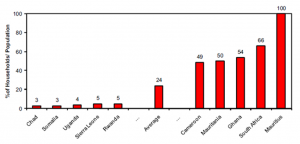
A community grows most successfully after the basic needs of the people are met. When society does not have to spend the majority of the day securing access to food, water, and shelter, it can give ample attention towards expanding and strengthening economic well-being. Steady access to electricity provides a stable foundation on which an economy may successfully expand and grow. Energy access provides a community the ability to acquire basic needs on a reliable basis. Steady access to electricity most effectively maintains medical facilities, which rely on power to run medical equipment and properly store vaccinations and medicines. Unreliable access to electricity presents a variety of negative implications for rural areas in SSA as these populations struggle with diseases such malaria, HIV/AIDS, and tuberculosis. Reliability poses a major obstacle in providing electrical access to SSA citizens. Power outages occur regularly and over 30 countries must rely on backup generators in attempt to supply power to the citizens.[11] These generators have been estimated to provide SSA as much as 750 MW of capacity.[12] So, even in areas that have infrastructure for energy dispersal, unreliable access remains a prevalent issue. Much of this can be attributed to unmaintained and nonoperational infrastructure that comprises 15% of the total installed capacity in SSA.[13]
Although the energy system currently operating throughout SSA is fragmented and inefficient, local governments have been formulating new solutions for ensuring a food supply and diversifying energy production.[14] Additionally many countries, such as the U.S. and those in the EU, regularly provide Africa with aid for development, and foreign direct investments are a commonplace in most African countries. Historically, these western-style nations have aimed to bring peace and democracy to SSA, and often allocate funds to help develop impoverished countries. However, these interactions SSA have been scrutinized by economist George Ayittey of Ghana. Based on his research, Ayittey believes that the western style approach to pushing democratization in Africa is the cause many contemporary problems on the subcontinent.[15] Furthermore he contends that the control and imposition of these countries does not allow SSA the freedom to grow and develop as individual nations. Instead it keeps the SSA countries reliant on foreign aid and prevents their ability to prosper on a local-community level.[16] Additionally, Ayittey warns caution about a new entity investing in and providing aid to SSA – China.[17]
China
In the late 1950s, the Chinese Communist Party began heavily endorsing African-centered research in China.[18] African studies were becoming an area of increasing interest among Chinese scholars and intensive research was rapidly developing among them. Eventually three universities set up Afro-Asian study programs to further China’s familiarity of the African continent.[19] During this time, African studies focused on development of solutions to colonialism as China was openly supportive of liberation moves taken by Africans and wanted to enhance its own relationship with SSA.[20] As interest increased, China’s oil consumption was rapidly increasing as well, and between the years 1950 and 1959, the annual oil imports to China increased from 0.33 million ton to 3.33 million tons.[21] However, when the Soviet Union stopped providing oil imports to China in the early 60s, it became necessary for China to explore for new sources. By 1963, the Daqing oil field was discovered and in production.[22] This new discovery allowed for China to fulfill 97% of its demand.[23] However, China’s economy was still growing tremendously and in the early 90s its oil consumption outpaced domestic production.[24] In consequence, China began to seek oil reserves from abroad to secure its rapidly growing nation.
Historically, China satisfied most of its energy needs through burning coal however, recently economic strategies have included plans to diversify the energy sector.[25] For this reason, China has been expanding its use of oil. Beginning in 1989, Chinese oil consumption began to rise rapidly due to an expanding economy and soon its ability to supply enough without relying on significant imports was surpassed. The increased demand that China placed on the oil industry has played a significant role in the fluctuation of global oil prices.[26] At this time China began purchasing large amounts of oil from SSA. This engagement soon led to the creation of the China-Africa Cooperation Forum (FOCAC) was founded in 2002. The FOCAC sought to strengthen the economic relationship between China and Africa, and the initiating conference was held on 12 October 2000.[27] From this time, trade between China and Africa has grown tremendously (Figure 3).
Hu Jintao was elected president of the People’s Republic of China in 2003. During his term his goals included strengthening the Communist influence and discouraging democracy trends. Together Jintao and the new Prime Minister Wen Jiabao presented themselves as gentle leaders with goals of providing aid to the people of China struck by poverty.[28] Throughout his term the Chinese economy consistently grew along with the energy demand. In order to conquer the problem of fulfilling the energy demand of the country China took an outward approach, looking for foreign destinations in which to invest in and secure oil reserves. Jintao embarked on several ambassadorial trips to countries in SSA that helped to strengthen the necessary ties for negotiating such trade.[29] However, China’s involvement with Africa has drawn a great deal of attention from United States and European nations.
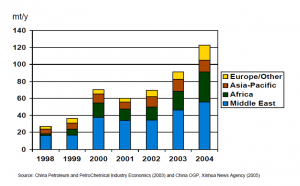
Historically, western-style approaches for distributing aid have dominated in SSA, so the approach China has taken towards involvement with SSA caused tensions with other nations in the world. While the western approach to SSA includes a great deal of interactions and pushes for democratization, Sino-approaches stress a lack of interference with the partnering economy.[30] China has rapidly become a significant trade partner with SSA countries, and as a result mutual trade totals escalated from $US10 billion in 2000 to $106.8 billion in 2008.[31] As trade continued to escalate between China and Africa, other nations began to scrutinize the growing number of ethical infractions. In response to these growing concerns, in 2006 Chinese Ambassador Liu Guijin addressed the African Business Leaders in Johannesburg to explain that China is currently modeling their approach after Zheng He, a Chinese navigator that travelled to Asia and Africa for trade over 600 years ago. To clearly explain the Chinese approach to SSA it is said,
“Zheng He took to the places he visited tea, chinaware, silk and technology. He did not occupy an inch of foreign land, nor did he take a single slave. What he brought to the outside world was peace and civilisation. This fully reflects the good faith of the ancient Chinese people in strengthening exchanges with relevant countries and their people. This peace-loving culture has taken deep root in the minds and hearts of Chinese people of all generations”[32]
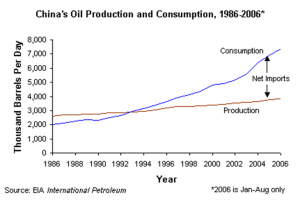
Trade between China and SSA readily continued after this point despite the growing criticisms. By 2009, China became the second highest consumer of oil only surpassed by the United States.[33] China’s economy has been growing rapidly along with the demand for oil making the production rate increasingly insufficient (Figure 4). Oil production in China reached a plateau and the need to continue securing reserves from abroad was becoming increasingly imperative.[34][35] Simultaneously, the number of Chinese people moving to SSA countries was rising starting at 580-820 living in SSA during 2009 to about one million resides within the subcontinent in 2012.[36]
During 2012 newly elected Chinese president Xi Jinping visited SSA in response to the negative implications that were continuing to emerge concerning Sino-African trade relationships, however speculation remains.[37] Although China claims to take an approach of noninterference, its relationship nevertheless changes the overall oil-business landscape of SSA. Analyzing the role China plays in a few select SSA countries will help exemplify the extent to which the countries are involved. Relationships with Sudan and South Sudan have been controversial with human rights groups, while current oil-centered activities in Kenya are expected to boost the economy for the first time in its history. Additionally, Angola and Nigeria are the top two oil exporters from SSA.
Angola
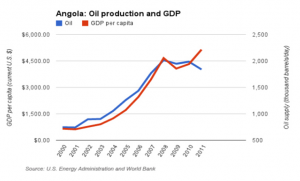
The Republic of Angola is located along the south western coast of SSA and possesses a population of approximately 200 million people. After gaining independence from Portugal in 1975, the people of Angola engaged in an atrocious civil war that lasted for 27 years and ultimately resulted in the death of over 1.5 million people. In 2002 the war ended however the country’s infrastructure experienced severe lack of attention during the many years of conflict. Infrastructure had become highly degraded and the people of the country were generally unprepared to fully handle the rebuilding processes. Much of the attempts to rebuild have been reliant on the abundance of oil reserves located in the country and since 2000 both the country’s GDP and oil production began steadily rising (Figure 5). This reliance on the oil industry has grown so strong that by 2012 over 90% of the countries revenue came from oil production.[38] Despite the appearances of a growing GDP, in reality the new wealth bypasses much of the population as over 50% of the local people in Angola live in poverty making less than $2/day.[39]
During the rebuilding processes, China was among the nations that extended aid. In 2004 for example, China granted Angola $US2 billion for infrastructure projects in exchange for Angola supplying China with 10,000 barrels of oil per day.[40] In 2005, China took advantage of offering Angola a $USD2 billion loan during a period when western nations chose to temporarily withdraw funds from the country as it dealt with issues of non-transparency in the government. This loan allowed for China to win oil reserves for which it had been competing with India.[41] Again, an oil-backed loan totaling $USD2 billion was extended to Angola in 2007 by the Export-Import Bank of China.[42] Oil exports from Angola to China continually increased and in 2010 Angola because the largest importer to China, surpassing even Saudi Arabia.[43] Along with securing oil reserves, the China International Fund (CIF) has initiated large-scale construction projects in Angola, such as Nova Cidade de Kilambaa social housing development just outside of the Angolan capital Luanda.
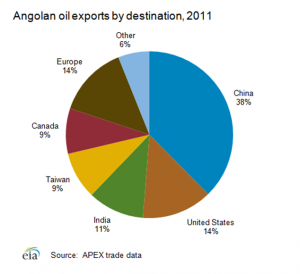
Touted by some as a ghost city, Nova Cidade de Kilamba was built by CIF during 2012 for the purpose of housing approximately 500,000 Angolans. This $USD3.5 billion development contains hundreds of eight-story apartment building, dozens of schools, and over 100 retail spaces within about 12,355 acres. Developments such as this have been built by Chinese companies up throughout the country however the average per capita GDP in Angola is $5,155/year while the apartments in places like Nova Cidade de Kilamba cost from $120,000 to $200,000.[44] So, for the average Angolan, four people would have to give up their entire yearly salaries to afford one apartment room in this complex. Consequently, within the first year of operations, only 220 of the 2,800 available apartments were rented. Some people speculate that China is constructing these development projects in order to prepare the economy of Angola to grow from future oil revenue.[45] As the top exporter of oil in SSA, Nigeria also possesses oil-driven relationships with China (Figure 6).
Nigeria
As a democracy with a population of 163.32 million people, Nigeria is the most densely populated country in SSA. Additionally, the economy relies heavily on oil exports as well as the country possesses membership with OPEC.[46] Although it was the agricultural sector in Nigeria represented 72% of the country’s GDP in 1950,[47] after the discovery of oil the national trend began to recede from agricultural business.[48] Many foreign oil companies were present in the country prior to the 50s however Nigeria began large-scale oil production after 1956 when the first oil reserve was discovered in Oloibiri.[49] Growing concerns from within the country about the expansion of the oil business soon led to the creation of the Nigerian National Oil Company (NNOC) in 1977. This organization’s goals include adding value to the countries petroleum products for the good of the local economy. This cultural shift would eventually cause non-oil sectors of the Nigerian economy to decrease from 94% in 1970 to 52% in 2004.[50] Since the development of petroleum resources, the economic landscape of Nigeria began changing and today the economy is entirely oil-dependent.[51] Many foreign interests operate within the country, including China.
The diplomatic relationship between China and Nigeria began in 1971 however the communication and involvement was the highest from 1999-2006. It was during this time that Chinese investment in the country increased from .02 million USD in 1999 to 5.5 million USD.[52] From 2003 to 2009, Nigeria was a top destination for Chinese trade second only to South Africa. At this time several business deals were negotiated that helped China accumulate oil reserves for its rapidly growing economy, including China National Overseas Oil Corporation purchasing a 45% stake in a Nigerian off-shore oil site worth $USD 2.27 billion in 2006.[53] Along with large purchases of reserves, loan-for-oil negotiations were also reached, such as a proposal in 2009 to offer $UD50 billion for six billion barrels of reserves.[54] Much like people in Angola, the majority of Nigerians live on less than $USD2 a day despite the abundance of wealth the country generates from oil revenue.[55]
Previous studies have indicated that successful, long-term development of Nigeria will require a large-scale economic shift away from the heavy reliance on an oil-based economy.[56] Diversifying the market and weaning off oil as its top commodity would allow more opportunities for business sectors to infiltrate into the local economy. Although a wealth of resources is contained within Nigeria, this has not yet provided the majority of the country with economic stability or positive development. The agricultural heritage of historical Nigeria has been lost to the oil industry and the people of the country have yet to achieve a stable economy. Chinese investment has provided Nigeria with oil revenue however this partnership has thus far failed to stimulate positive growth. Another economically-unstable region with which China has been controversially involved since the 90s is Sudan, and more recently South Sudan.
Sudan
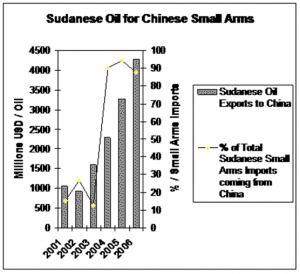
Oil was first discovered in Sudan during the late 50s, followed in the subsequent decades by involvement from several countries around the world. However soon after this, social and political unrest throughout the country caused a civil war to ensue between northern and southern Sudan. In 1978, more oil was discovered in the Bentiu region, which accelerated disputes within the country. Civil unrest in this area results in constant involvement from human rights activists, and as a result the U.S. imposed trade sanctions in 1997.[57] This caused many companies to withdraw from operations in Sudan. China’s fist engagement with Sudan began in 1996 and has since become its single largest stakeholder in Sudanese oil, with the China National Petroleum Corporation holding a 40% share in the Greater Nile Petroleum Operating Company, Sudan’s largest oil company.[58] Today, as much as 60% of Sudan’s oil exports are destined for the Chinese economy. This has enabled Sudan to gain benefits from oil exports since 1999 as China then secured 40% of the Sudanese international consortium extracting oil in the area.[59]
Activity by the Chinese in Sudan has attracted the attention of the Human Rights Watch Group.[60] While China stresses a partnership based on noninterference, other economies involved with SSA have taken notice to the correlation between Chinese monetary investment and the increase in arms and violence within Sudan (Figure 7). Civil War and unrest in Sudan has caused a large amount of violence throughout the country, and much of the recent warfare and attacks were a result of the possession of Chinese weaponry. Furthermore, weapons purchased from China have been responsible for the genocidal activities and pillaging of the Darfur region of western Sudan.[61] This correlation has caused the Human Rights Watch Group to question the moral and ethical integrity of China’s involvement with Sudan. Nevertheless, petroleum-driven trade continues to dominate the relationship between China and Sudan.
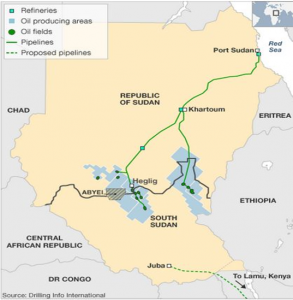
In 2011, South Sudan declared independence from Sudan while also securing up to 75% of the oil reserves. This totaled to about 490,000 barrels a day and much of this is primarily pumped by the China National Petroleum Corp.[62] Much of the reserves are located along the border area of South Sudan and Sudan, so oil-driven disputes have been erupting amongst the two nations. Some complications involve transportation because the pipelines from South Sudan run though Sudan before they are able to reach the North Sea (Figure 8). For this reason, in 2011 Sudan threatened to impose a tax on South Sudan to be able to transport its oil through the pipeline across Sudan. During this time, China’s special representative for African affairs, Zhong Jianhua, had been visiting South Sudan for the purpose of easing the tensions with Sudan.[63] Although South Sudan decided to halt oil production, an agreement was reached March 2012 and oil production resumed after a 15 month hiatus.[64] Since this time, agreements were reached which will allow the construction of a major pipeline, the Lamu Port-South Sudan-Ethiopia Transit Corridor (LAPSSET), to connect South Sudan, Ethiopia, and Kenya. While historically Kenya has not been a major contributor to the petroleum industry, recent discoveries have offered the country the opportunity to establish an integral role in the business. Currently, Kenya has already accepted Chinese investment for the initiating construction projects of LAPSSET, the new multi-billion USD infrastructure project for the country.
Kenya
Out of a population of 38.3 million people, 46% of Kenyans currently live in poverty.[65] Many of the people live in rural areas, so access to electricity is limited or non-existent. To help address this issue, the Kenyan government created the 2030 plan which is aimed at elevating the country of Kenya from poverty to a middle-income status.[66] Long-term goals of the Kenyan government include creating by 2030 an industrialized country with a mid-level income, a high quality of life, and a clean environment.[67] Although historically the majority of Kenyan economic activity revolved around agriculture and tourism, the past couple of years have allowed the oil industry has become more active in the country. In the recent past, inland Kenya was not known to possess oil however in November 2012 the first discovery was uncovered by Tullow Oil.[68] Since this time, investments in Kenya by foreign oil countries have been rising including those from China.
Although China had been involved with Kenya’s oil business since 2006, the extent was limited to off-shore reserves.[69] The interest quickly extended inland after the discovery by Tullow. By the time of this discovery, China’s relationship with Kenya was already well established, and this was partially exemplified by the period from 2001-2011 when China granted Kenya $US1.4 billion for funding a variety of social infrastructure needs. The largest of these projects, valued at $US138 million, has a goal of updating Kenya’s urban power grid which would allow for higher access rates in urban areas.[70] Much like the majority of SSA, Kenya has low access to electricity, so the aid from China has been well received by the Kenyan government.
Currently, Kenya is working in conjunction with South Sudan and Ethiopia to construct the Lamu Port and South Sudan Ethiopia Transport (LAPSSET). This infrastructure project would allow for the transport of oil to promote economic trade and development between the countries. All three countries, South Sudan, Kenya, and Ethiopia, have optimistically agreed to contribute a portion to the $USD23 billion investment this project is expected to cost.[71] Kenyan government has confidence that this project will open up the door of economic opportunity and, along with its partner countries, has been trying to attract foreign and private investors. China has been amongst the entities willing to invest heavily in this project and in 2013 the China Communications Construction Company won the $USD484 million tender to lead the first of the berths included in the project plans for Lamu.[72] Local people of Lamu, however, are not responding to the new pipeline positively and have even attempted to prevent the project through legal means.[73]
Located off the coast of Kenya, Lamu contains a population of approximately 100,000 people – 90% of which depend on fishing and tourism to maintain financial well-being. Along with high levels of biodiversity and ecological wealth, Lamu possesses one of the oldest Swahili communities in SSA.[74] Many people living in the communities of Lamu believe that the proposed infrastructure to complete the LAPSSET threatens the long-term integrity of the island’s heritage. One area of particular is Lamu Old Town, a World Heritage Site in which the most well-preserved traditional Swahili tribes in East Africa are located. Locals claim that the new infrastructure will compromise the integrity of the area’s traditional appeal for tourism. For this reason, lawyers challenged the development project in the High Court on account of insufficient environmental planning and an activist group called “Save Lamu” has emerged as well.[75] Despite the resistant, the Kenyan government believes that sacrifices from the cultural heritage of Lamu and its people will be necessary to achieve the much-desired economic growth.
Conclusion
Overall, SSA contains a great amount of natural wealth however much of this wealth is exported to other larger and growing economies. Despite the approach of noninterference the Chinese have chose to take with African relations, SSA has yet to achieve an economic future of promise. Poverty still remains prevalent throughout the subcontinent, and much of the agricultural industry which had previously supported countries such as Nigeria has been lost to the oil industry. The oil industry has managed to significantly boost the GDP in many areas however the majority of the native people continue to live in poverty. This trend seems to resonate across many countries in SSA, as only a minority of people earns a reasonable living wage. Although China approached SSA differently than western nations, the ultimate goal is still suiting inward interests. Based on the social aspects of involvement in Sudan, South Sudan, Kenya, Angola, and Nigeria, financial assistance and trade partnerships from China seem to benefit the people in SSA very little. SSA has yet to achieve overall stability and the new form of involvement from China does not appear to be contributing to a viable, long-term solution.
References
[1] World Bank, ‘Sub Saharan Africa’, The World Bank [web page] (2013), <http://data.worldbank.org/region/sub-saharan-africa>, accessed 20 March 2013.
[2] Anton Eberhard and Maria Shkaratan, “Powering Africa: Meeting the financing and reform challenges”, Energy Policy 42, (2012), p. 9.
[3]Orvika Rosnes and Haakon Vennemo, “The cost of providing electricity to Africa”, Energy Economics, 34 (2012), p. 1318.
[4]Vivan Foster and Cecilia Briceno-Garmendia, Africa’s infrastructure: A Time for Transformation, (World Bank, 2010), p. 182.
[5]Abeeku Brew-Hammond, “Energy access in Africa: Challenges ahead”, Energy Policy, 38/5 (2010), p. 2292.
[6] World Bank, “Sub-Saharan Africa”, The World Bank Data, http://data.worldbank.org/region/sub-saharan-africa, accessed 20 April 2013.
[7] Traditional biomass in Africa generally refers to the use of firewood. People in SSA, especially in rural areas, rely heavily on firewood as source of energy primarily for cooking. In this case, an increased use of biomass suggests that an increasing number of people will be without electricity.
[8]Abeeku Brew-Hammond, “Energy Access in Africa: Challenges ahead”, Energy Policy 38, (2012), p. 2292.
[9]Abeeku Brew-Hammond, “Energy access”, p.2292.
[10]Ogunlade Davidson, Manuel Chenene, Evans Kituyi, JabavuNkomo, Clive Turner, Ben Sebitosi, “Sustainable Energy in sub-Saharan Africa”, ICSU Regional Office for Africa: Science Plan, (2007), p. 6.
[11] Vivian Foster, Africa’s Infrastructure, p. 182.
[12] Anton Eberhard, “Powering Africa”, p. 9.
[13]Anton Eberhard, “Powering Africa”, p.9.
[14] David L. Sparks, “Large Scale Land Acquisitions in Sub-Saharan Africa: The New Scramble?”, International Business & Economics Research Journal 11/6, (2012), p. 687.
[15] On an interesting note, Ayittey created an analogy to illustrate western intervention in SSA using hippos and cheetahs. The hippo generation, AKA the ruling elite, created their ideas about the future of Africa from previous generations and believes that the only way to pull SSA out of poverty is to collect foreign aid and provide the states more power. The cheetahs are the new, invigorated young leaders of SSA that are not content with the rest of the world seeing the development of SSA as a business opportunity. For more detailed information on this, see his TED talk entitled “George Ayittey on Cheetahs vs. Hippos”.
[16]George Ayittey, “Why Western-style democracy is not suitable for Africa”, African Voices, 20 August 2010.
[17] During an interview with TV3 Ghana on 1 May 2010, Ayittey expressed some of his concerns about China. An interesting problem Ayittey discovered during his research into Sino-African relations was a secret plan of the Chinese called the Ching-Chong plan. This secret plan sought to relocate 12 million people to Africa. He believes that this is an attempt by China to re-settle the surplus population.
[18] Sanusha Naidu, Stephen Marks, and Axel Harneit-Sievers, Chinese and African Perspectives on China in Africa (Cape Town: Pambazuka Press, 2010), pp. 2-3.
[19]Sanusha Naidu, Chinese and African, p. 3.
[20]Sanusha Naidu, Chinese and African, p. 4.
[21]Hong Zhao, “China’s Oil Venture in Africa”, East Asiai 24, (2007), p. 400.
[22]Hong Zhao, China’s Oil”, p. 399.
[23] Hong Zhao, “China’s Oil”, p. 400.
[24]EIA, “China”, U.S. Energy Information Administration, http://www.eia.gov/countries/country-data.cfm?fips=CH, accessed 20 April 2013.
[25] Ali Zafar, “The Growing Relationship Between China and Sub-Saharan Africa: Macroeconomic, Trade, Investment, and Aid Links”, World Bank Research Observer, 22/1 (2007), p. 118.
[26] Ali Zafar, “Growing Relationship”, p. 118.
[27] This date was obtained from the FOCAC website. Additional information about this organization is kept up to date and can currently be retrieved from www.focac.org.
[28] Tim Luard, “China’s leader shows his stripes”, BBC News, 11 January 2005, [on-line database], accessed 15 March 2013.
[29]Centre for Chinese Studies, “Evaluating Chinese President Hu Jintao’s tour of Africa”, The China Montor 15, (2007), p. 4.
[30] GAO, “Sub-Saharan Africa: Trends in US & Chinese Economic Engagement”, Report for Congressional Requestors, February 2013, p.3.
[31] Bobbie Macdonald, “China’s Policy of Non-Interference in Sudan”, Undercurrent Journal 7:3, (2010), p. 8.
[32]Moyiga Nduru, “CHINA: Oil, Global Influence Driving Hu Jintao’s Africa Trip”, Inter Press Service News Agency, 29 January 2007, http://www.ipsnews.net/2007/01/china-oil-global-influence-driving-hu-jintaos-africa-trip/, accessed 20 April 2013.
[33] EIA, “China”, 2013.
[34] EIA, “China”, 2013.
[35]See Appendix D.
[36] Yoon Jung Park, “Living in Between: The Chinese in South Africa”, Migration Information Source (Washington D.C.: Migration Policy Institute, 2012), p. 1.
[37] Katie Hunt, “China’s Xi promises equal trade relations with Africa”, CNN News, 26 March 2013, www.CNN.com, accessed 24 April 2013.
[38] Victoria Eastwood and David McKenzie, “The billion-dollar question: Where is Angola’s oil money?”,BBC News, 29 November 2012.
[39] BBC, “Angola: Ten years of peace but at what price?”, BBC News, 4 April 2012, www.bbc.co.uk/news/world-africa-17589021, accessed 13 April 2013.
[40]Bobbie Macdonald, “China’s Policy“, p. 7.
[41] Raphael Kaplinsky, Dorothy McCormick, and Mike Morris, “Working Paper 291: The Impact of China on Sub-Saharan Africa”, (Brighton: Institute of Development Studies, 2007), p. 42
[42] Indira Campos and Alex Vines, “Angola and China: A Pragmatic Relationship”, (Chatham House, London: Center for Strategic International Studies, 2008), p. 8.
[43] Rafael Marquez, “The New Imperialism: China in Angola”, World Affairs Journal March/April (2012), www.worldaffarirsjournal.org.
[44]Louise Redvers, “Angola’s Chinese-built ghost town”, BBC News: Africa, 2 July 2012.
[45]Louise Redvers, “Angola’s Chinese-built”, 2012.
[46] Nigeria became an OPEC member in 1970. During the late 60s, the Arab-Israeli War prompted a drastic rise in oil prices. This encouraged other countries to seek more reliable sources for petroleum products in places such as Nigeria. Ebohon, “Nigeria”, p. 201.
[47] SI Ebohon, “Nigeria: State, Oil and Malignant Underdevelopment”, The Western Journal of Black Studies 36:3, (2012), p. 201.
[48] During this time, 70% of exports were from agriculture as well as the country produced 95% of the people’s food needs. This stands in stark contrast to the economic activity of Nigeria today as the #1 oil producer in all of SSA. Ebohon, “Nigeria”, p. 201.
[49] Nigerian National Petroleum Corporation, “History of the Nigerian Petroleum Industry”, NNPC [webpage] (2013), http://www.nnpcgroup.com/NNPCBusiness/BusinessInformation/OilGasinNigeria/IndustryHistory.aspx, accessed 01 April 2013.
[50] E. Olawaleogunkola, Abiodun S. Bankole and Adeolu Adewuyi, “China-Nigeria Economic Relations”, University of Ibadan, (2008), p. 1.
[51]Ebohon, “Nigeria”, p. 217.
[52]Ogunkola, “China-Nigeria”, p.2.
[53] John Whalley (ed.), China’s Integration into the World Economy, (Singapore: World Scientific Publishing Co., 2011), p. 243.
[54] Spencer Swartz, “China mops up oil reserves in Nigeria”, The Australian, 10 December 2009, p. 26.
[55] Andrew Walker, “The day oil was discovered in Nigeria”, BBC News, 17 March 2009.
[56]Ogunkola, “China-Nigeria”, p. 1.
[57] Embassy of the United States, “US-Sudan Relations”, Embassy of the United States: Khartoum – Sudan [webpage] (2013], http://sudan.usembassy.gov/ussudan_relations.html, accessed 30 March 2013.
[58] John Whalley (ed.), China’s Integration, p. 244.
[59] Roberta Cohen, “Calling on China: The China-Darfur Connection”, The Washington Post via The Brookings Institute, 5 August 2004.
[60] Human Rights Watch, “Human rights in Sudan”, Human Rights Watch [webpage] (2013) www.hrw.org/africa/sudan, accessed 30 March 2013.
[61] Since China has been operating in Sudan, thousands of people have been forced to vacate their homelands without compensation for the sake of oil development. Likewise, an increasing number of weaponry from China has been used in the genocide-centered tactics for removing indigenous people in the Darfur region. Much information concerning this connection between China and violence in Sudan can be found on the Human Rights Watch website at http://www.hrw.org/reports/2003/sudan1103/26.htm.
[62]Jared Ferrie, “South Sudan, Kenyan Governments Sign Accord to Build Oil Pipline Via Lamu”, Bloomberg, 25 January 2012.
[63] Sudan Tribune, “China pledges cooperation with South Sudan”, Sudan Tribune, 15 March 2012, [website] http://www.sudantribune.com/China-pledges-cooperation-with,41909.
[64] BBC, “Sudan rival ‘to resume pumping oil’”, BBC News Africa, 12 March 2013.
[65]UNICEF, “Kenya at a glance”, UNICEF Kenya Country Program 2013.
[66] Kenya Vision 2030, “About ,Kenya Vision 2030, [webpage] www.vision2030.go.ke (2011), accessed 30 April 2013.
[67] UNPD, “About Kenya”, [website], 2013.
[68] “Tullow discovers Kenya’s first oil”, TCE: The Chemical Engineer 85, (2012), p.17.
[69] In 2006, Chinese president Hu Jinato organized a contract with Kenyan government which allowed China to prospect along the coast. Since China’s economy was growing quickly, Jinato was touring China during this time building good relationships and trying to locate enough energy and raw materials for China. BBC News, “Kenya Profile”, 2013, retrieved from http://www.bbc.co.uk/news/world-africa-13682176.
[70] Kevin J. Kelley, “Chinese gives Kenya $1.4bn aid in decade”, Daily Nation, 1 May 2013.
[71] BBC, “Lamu port project launched for South Sudan and Ethiopia”, BBC News Africa, 2 March 2012.
[72] Galgalo Bocha, “Kibaki to lay foundation stone for Lamu port”, Business Daily, 13 January 2013.
[73] Save Lamu, “PRESS RELEASE: Lamu Community Members to Take Legal Action Over the Lack of Consultations with the Lamu Port”, 24 January 2012, Save Lamu [website] (2013), http://www.savelamu.org/press-release-lamu-community-members-to-take-legal-action-over-the-lack-of-consultations-with-the-lamu-port/, accessed 25 April 2013.
[74] Save Lamu, “About Laum, Save Lamu [website] (2013), www.savelaum.org/about-lamu/, accessed 25 April 2013.
[75] Tristan McConnell, “Upwardly mobile: Kenya is yet to come of age with ambitious plan; An infrastructure project linking Kenya with Ethiopia and Sudan in proving controversial”, The Times (London) National Edition (1), 30 April 2013, p. 12-13.
Biography
 Now a senior, I have enjoyed a great deal of academic opportunities that I have learned from tremendously. The first conference I participated in at SEU was SOURCE and I presented a research project over hunting policies in Kenya. Most recently I was accepted into the McNair Scholars Program, for which I conducted an independent research project analyzing how the border fence between Texas and Mexico has affected ocelot conservation in the U.S. I’ve had the fortuity to present this research at the McNair Research Symposium here at SEU. After graduation I plan on obtaining my PhD in wildlife conservation.
Now a senior, I have enjoyed a great deal of academic opportunities that I have learned from tremendously. The first conference I participated in at SEU was SOURCE and I presented a research project over hunting policies in Kenya. Most recently I was accepted into the McNair Scholars Program, for which I conducted an independent research project analyzing how the border fence between Texas and Mexico has affected ocelot conservation in the U.S. I’ve had the fortuity to present this research at the McNair Research Symposium here at SEU. After graduation I plan on obtaining my PhD in wildlife conservation.

